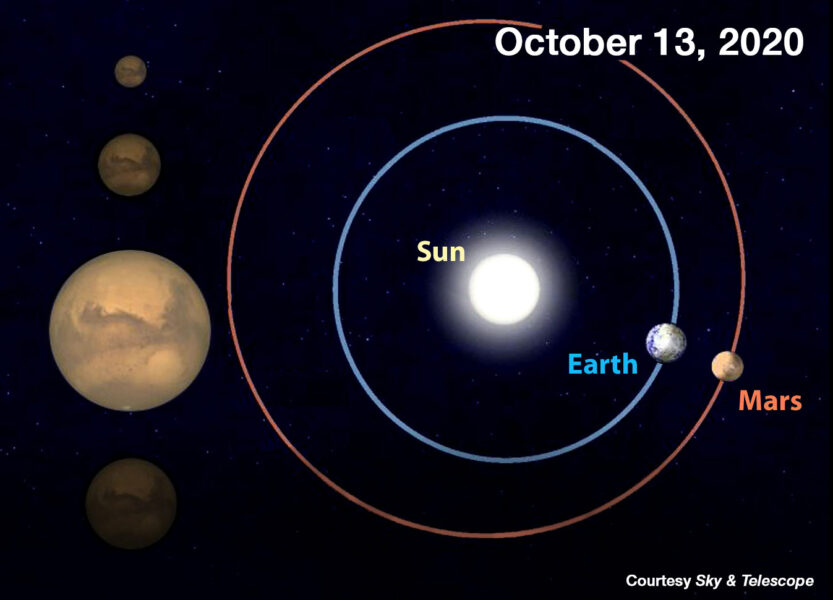Mars at opposition shines extra bright in the night sky tonight
You don't want to miss Mars tonight.

Mars reaches opposition today, Oct. 13, offering skywatchers an early Halloween treat.
During opposition, Mars, Earth and the sun form a straight line, with Earth in the middle. As a result, the Red Planet appears bigger, brighter and redder than usual — and the planet won't get this close to Earth again until 2035, according to a statement from Sky & Telescope.
While Mars will be at its maximum apparent size when viewed through a telescope, the Red Planet actually made its closest approach to Earth last week, on Oct. 6, when the two planets were separated by just 38.6 million miles (62 million kilometers).
Related: Mars Opposition 2020: Here's what you need to know
Mars orbits the sun at a greater distance than Earth and takes about 26 months to complete one orbit around the sun. Due to these different orbital speeds, Mars oppositions occur every two years or so.
For this year's Mars opposition, observers in the Northern Hemisphere will have an exceptional view of the Red Planet, which is positioned farther north and higher in the sky than during the 2018 event, according to Sky & Telescope.
Related: You don't want to miss Mars shining bright this fall
Get the Space.com Newsletter
Breaking space news, the latest updates on rocket launches, skywatching events and more!
"Indeed, Mars won't be comparably close and well-positioned for northern observers again until it reaches opposition in 2052, making this year's opposition all the more noteworthy," Gary Seronik, consulting editor for Sky & Telescope magazine, said in the statement.
For most of October, the Red Planet will appear brighter than any other object in its vicinity. Mars will rise in the east as the sun sets, and reach its peak in the night sky at midnight, when it is high above the southern horizon. While Mars is easy to distinguished thanks to its reddish color and is visible to the naked-eye during opposition, skywatchers will still want a high-quality telescope to view its famous surface features in greater detail.
The planet will continue to rise earlier and earlier in the weeks following opposition, before it gradually begins to fade. Then, by the end of November, Mars will be only a quarter as bright as it is tonight — or slightly fainter than Sirius, the brightest star in the night sky, according to Sky & Telescope.
Mars also reached what is called "perihelic opposition" on Aug. 3. Perihelion refers to the point in Mars' orbit when it's closest to the sun. Therefore, when Mars is closest to the sun, it is even closer to Earth during opposition. Since August, the Red Planet has slowly been moving farther from the sun.
Editor's note: If you snap an amazing photo of Mars and would like to share it with Space.com for a story or photo gallery, send comments and images to spacephotos@space.com.
Follow Samantha Mathewson @Sam_Ashley13. Follow us on Twitter @Spacedotcom and on Facebook.
Join our Space Forums to keep talking space on the latest missions, night sky and more! And if you have a news tip, correction or comment, let us know at: community@space.com.

Samantha Mathewson joined Space.com as an intern in the summer of 2016. She received a B.A. in Journalism and Environmental Science at the University of New Haven, in Connecticut. Previously, her work has been published in Nature World News. When not writing or reading about science, Samantha enjoys traveling to new places and taking photos! You can follow her on Twitter @Sam_Ashley13.









